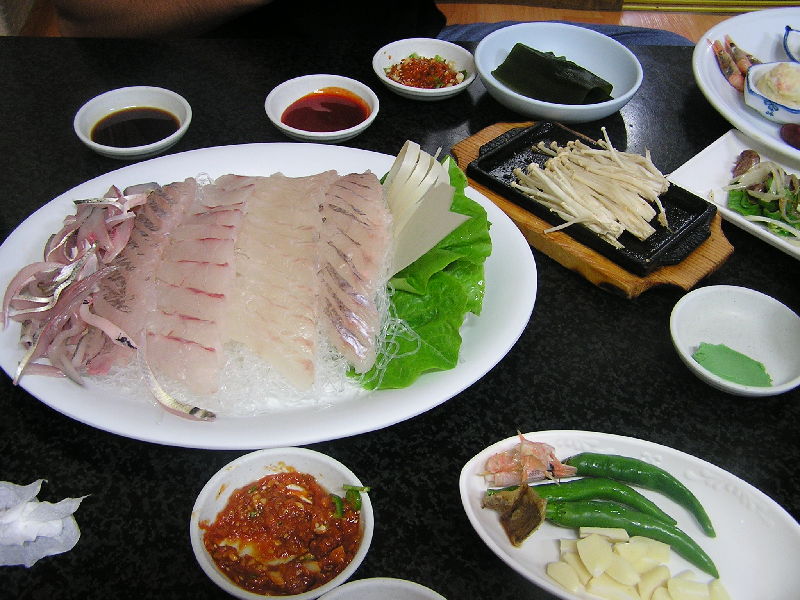- Hoe (dish)
Infobox Korean name
title=Hoe
hangul=회
hanja=
rr=hoe
mr=hoe"Hoe" (pronounced|hwe) may refer to various raw food dishes in Korean cuisine. "Saengseon hoe" (생선회) is thinly sliced raw fish or other raw seafood (similar to Japanese "
sashimi "); "yukhoe " (육회) is "hoe" made with a raw beef and seasoned with soy sauce,sesame oil , and rice wine; and "gan hoe" (간회) is raw beefliver with a sauce of sesame oil and salt.Fish "hoe" is usually dipped in a spicy "
gochujang "-based sauce called "chogochujang" (초고추장), "ssamjang" (쌈장), orwasabi sauce, and wrapped inlettuce and Koreanperilla leaves. To make "hoe" aesthetically pleasing, it is often served on of a mass of uncooked "dangmyeon" (cellophane noodles).When people finish a meal of "saengseon hoe" at a restaurant, they sometimes order "
maeuntang " (spicy fish stew, from the fish heads and remaining meat) together with various vegetables.History
It can be assumed that the tradition of eating "hoe" was introduced from China to Korea during the early Three Kingdoms Period (57 BC-668 AD), facilitated by frequent interchanges between China and the Korean peninsula. According to the Confucian "
Analects ", written in the 1st century BC,Confucius said "Do not shun rice that is well clean; do not shun "kuai" that is thinly sliced" (食不厭精,膾不厭細). [http://www.afpc.asso.fr/wengu/wg/wengu.php?no=248&l=Lunyu] While the term "kuai" (linktext|膾) originally referred to finely sliced raw fish or other meats such as beef or lamb, since the Qin and Han Dynasties it has referred mainly to raw fish. However, since Buddhism flourished in Korea from the middle part of the period until the lateGoryeo Dynasty (918–1392), the killing of living beings was avoided, so that the habit of eating meat in general almost disappeared along with eating "hoe". As the dominant influence of Buddhism fell off in the late Goryeo period, the consumption of "hoe" was revived. During theJoseon Dynasty, the state highly regardedConfucianism , and, as Confucius was known to have enjoyed eating raw meat, eating "hoe" was accepted without any resistance at that time.cite news|url=http://h21.hani.co.kr/section-021087000/2003/07/021087000200307160468051.html |title=공자 사모님 힘드셨겠네 |publisher=The Hankyoreh |date=2003-07-16 |author=Kim Hak-min (김학민) |language=Korean |accessdate=2008-08-23]On the other hand, the consumption of raw meat or seafood is rare in present day
Chinese cuisine apart from in a few regions, such as theChaozhou dish "yusheng ". A 20th century Taiwanese-Japanese historical novelist,Chin Shunshin , speculates that the consumption of raw meat disappeared after an epidemic spread to the continent in the 11th century. In light of a poem composed byMei Yaochen , a leading poet of theSong Dynasty , which depicts a host presenting "kuai" for waiting guests, it appears that the consumption of raw meat dishes was thriving until at least that time.References
Gallery
ee also
*
Yukhoe
*Sannakji
*Hoedeopbap
*Maeuntang
*Korean cuisine
*Kuai (dish)
*Namasu
*Sashimi
*Yusheng External links
* [http://ics1.mk.co.kr/icsView30.php?community_cd=mm129_v1&no=62&field=&key=&start=30&programCode=417 생선회의 역사와 정보]
Wikimedia Foundation. 2010.
